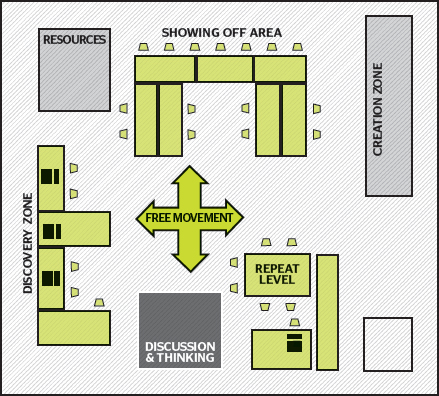No timetable, no lesson plans, but plenty of excitement and discovery. Kevin McLaughlin describes how technology has helped...
Monday, 9:40 am. My class returns from assembly and a few pupils hand out the Personal Journeys for the week ahead. Children sit quietly for a minute reading through their Journey, adding their own ideas on how they will achieve the targets I have set. There is no mass exodus from seats to the carpet and no focus on me to provide an introduction. Every child has control over his or her learning and quickly sets off to achieve it. Some do maths and calculation, others continue with project work they have devised themselves. At any one time there could be two or three subject areas on the go. Yet there is no chaos, no panic, no behaviour issues, and I have time to see each and every child, assess his or her learning on the spot and revise targets.
My decision to explore personalising learning came through a desire to improve my teaching and give children greater control over what and how they learn. The current ‘one-size-fitsall’ approach, which breaks down prescribed lessons into differentiated tasks, does not meet the needs of the individual; personalised learning for each and every pupil can. Integrating it into your own classroom will take time and effort – planning has to be adjusted as personalised learning can not be shoehorned into your existing plans. Are you ready to give it a go?
Traditional planning puts the teacher first. It lays out the week ahead and details every aspect of the lessons to be taught. Learning objectives are broken down into manageable, differentiated chunks and, during the main activity, children - grouped by ability/ mixed ability - are expected to meet these targets in a given time frame. There is very little room for manoeuvre and, as such, struggling learners will be left behind if they do not keep up.
My planning ensures learners’ needs are met through selected targets derived from formative assessment and based on National Curriculum objectives. The planning does not set out a timetable for each day, has no requirement that pupils work on the same subject at the same time, and gives children the freedom to choose the content of their learning. I call these plans Personal Journeys – to which each pupil can add her own learning targets, ideas and project based enquiries. Fig. 1 is an example of one child’s Journey and what she intends to do during the week ahead
Resources play a major part in this approach and learners must have access to any they require. Technology has been integral to the success of personalised learning in my classroom, so much so that I advised the school to free up an area of the ICT suite and invite pupils to use this at any time during the day.
Children in my class have access to four laptops, five iPads and five PCs. Technology is used not only to find content but also to create it. This content is then shared with others in the class and also posted onto our class blog. Technology has made my personalised learning approach more accessible and manageable, it’s given children the power to further develop their understanding and has unleashed new avenues of learning.
You do not need to have a suite full of tech to make this happen. Start by giving over your teacher laptop to the class . Look at freeing up your ICT suite for all learners to use as a drop-in learning centre. Ask your ICT lead teacher to make school laptops, mobile devices and any other technology available so that every learner can access it as and when it’s needed. You could even discuss the possibility of children bringing in their own devices from home to aid their learning.
Every child in my class has responded favourably to the use of Personal Journeys. My current action research has shown that, in one term, 67% of my class moved up one mini-level or more in maths whilst 85% had moved up one mini-level or more in English. With the end of term three approaching, my current teacher assessment shows the class meeting and in some cases surpassing average age expectations.
Personalising the curriculum for every child in my class has been an inspiring journey. I have watched in awe as children have worked together to think through problems and come up with solutions. It has confirmed my belief that if we give learners the opportunity to follow a personalised approach, they will fly. After the very first week of using Personal Journeys in my class, I noted the following outcomes:
Personalising learning isn’t the magic bullet, but it does make the classroom a more vibrant, exciting place for learning to take place. Go on, make learning personal.
Supporting personalised learning means reorganising your classroom. This requires a good understanding of your learners and how they interact with each other. You need to be prepared to allow children to move around, to interact with their peers, to sit anywhere with anyone, to use the floor space as well as a tables, and not to use groupings of any sort unless there is a specific reason for it.
This classroom layout allows my class the freedom to explore their learning in a way that would not be possible if they were grouped by ability and had specified seating. You can watch a video about this on YouTube http://bit.ly/classorgvid
Find out more about reorganising your classroom for personalised learning on my blog bit.ly/classorg and discover what personalised learning entails from Barbara Bray barbarabray.net/personalized-learning

Make World Book Day Extra Special This Year
Ace-English
How children react to a moral dilemma may be down to your teaching
Ace-Classroom-Support
